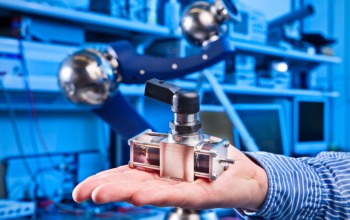Piezohydraulic Actuator: A Powerful Midget

The concept combines piezomechanics with hydraulics. A voltage causes tiny deflections in a piezoelectric crystal and an internal hydraulic system combines these small movements to generate a rise of two centimeters. Purely electromagnetic actuators loose efficiency if they are very small.
Another advantage of the new actuator is its metallic enclosure, which ensures that all of the required hydraulic fluid is contained in the system so that the actuator only has to be supplied with electricity and not with fluid. Moreover, the actuator is protected against external influences such as dust, humidity, and chemicals.
Piezoelectric crystals expand in a particular direction as soon as a voltage is applied. These crystals are used to drive injection valves in combustion engines, for example. One of their advantages is their dynamic response. Due to their great stiffness, they respond with almost no lag. By contrast, a conventional hydraulic system needs to have a central pump compress the hydraulic fluid in all of the system's pipes before it can generate a mechanical motion.
The piezohydraulic actuator developed by Siemens' global research department Corporate Technology (CT) achieves a high level of stiffness because it only needs six milliliters of hydraulic fluid. The enclosed hydraulic system consists of three adjacent metallic bellows that can expand along an axis and are connected to one another by non-return valves. If the piezoelectric crystal is excited, it expands into the central chamber, where it creates pressure.
This pressure opens the valve to the adjacent chamber, which has an actuator stem attached to its front. The inflowing fluid slightly expands the bellows and the actuator stem is extended. Using a patented integration solution, the developers achieve a total rise of two centimeters:
They operate the piezoelectric crystal with a high-frequency sawtooth voltage and combine the rapid succession of small expansions to create a completely smooth motion of the actuator stem. The concept has two advantages:
If the reverse voltage waveform is applied, the pumping direction and the motion are reversed as well. In addition, the actuator maintains its extension once it has been set. By contrast, the actuators used in conventional gears to transmit power cannot withstand vibrations and other influences over the long-run.
The system is a further development of a piezohydraulic actuator that CT created for controlling the valves of large-scale combustion engines such as gas turbines. According to the developers, the new actuator might also be used for other applications such as in robots, in the operation of aircraft ailerons, and in medical and cleanroom technology.
Media Contact
All latest news from the category: Machine Engineering
Machine engineering is one of Germany’s key industries. The importance of this segment has led to the creation of new university degree programs in fields such as production and logistics, process engineering, vehicle/automotive engineering, production engineering and aerospace engineering among others.
innovations-report offers informative reports and articles covering technologies such as automation, motion, power train, energy, conveyor, plastics, lightweight construction, logistics/warehousing, measurement systems, machine tools and control engineering.
Newest articles

Zap Energy achieves 37-million-degree temperatures in a compact device
New publication reports record electron temperatures for a small-scale, sheared-flow-stabilized Z-pinch fusion device. In the nine decades since humans first produced fusion reactions, only a few fusion technologies have demonstrated…

Innovative microscopy demystifies metabolism of Alzheimer’s
Researchers at UC San Diego have deployed state-of-the art imaging techniques to discover the metabolism driving Alzheimer’s disease; results suggest new treatment strategies. Alzheimer’s disease causes significant problems with memory,…

A cause of immunodeficiency identified
After stroke and heart attack: Every year, between 250,000 and 300,000 people in Germany suffer from a stroke or heart attack. These patients suffer immune disturbances and are very frequently…





















